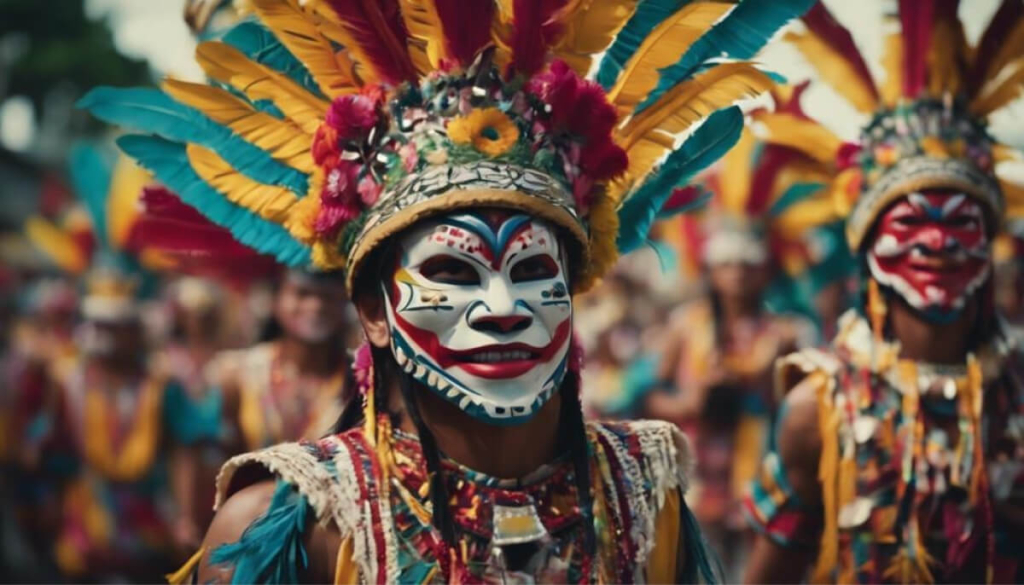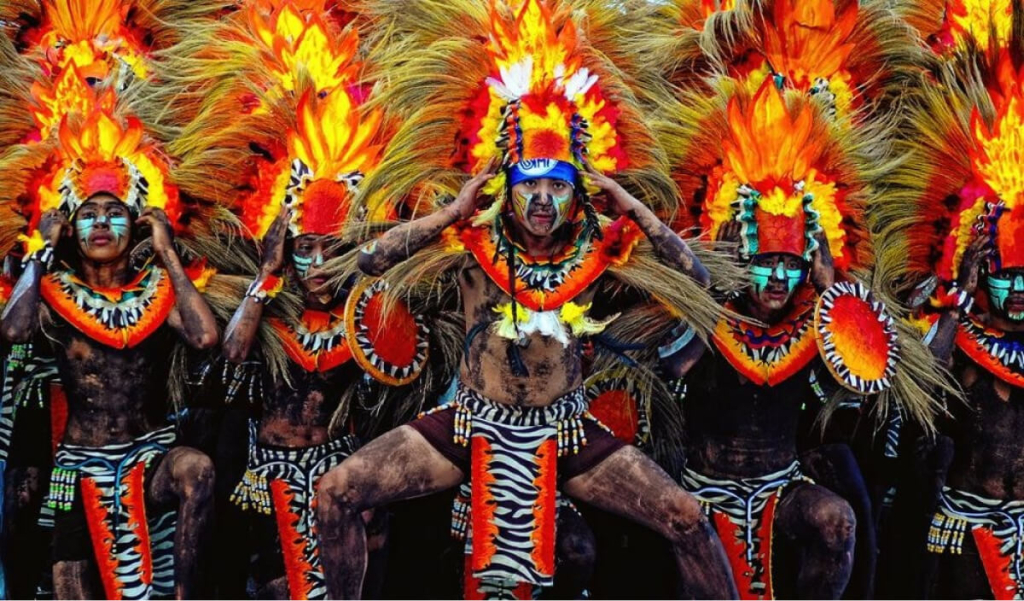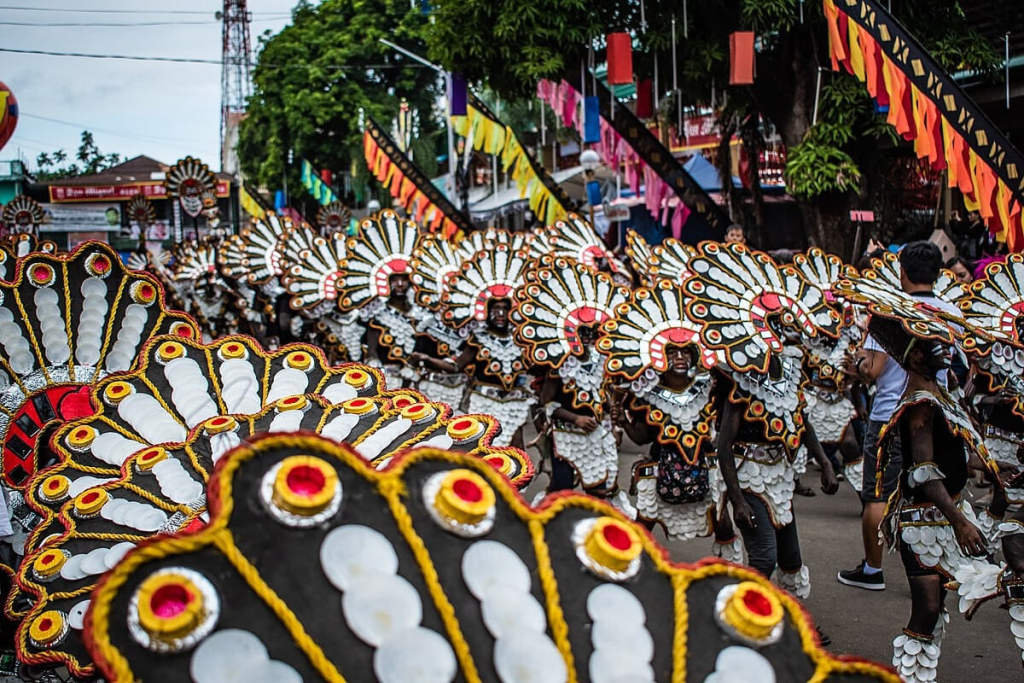
Philippine festivals are a testament to the country’s rich cultural heritage, and one of the most iconic and oldest festivals is the Ati-Atihan Festival. Held annually in Kalibo, Aklan, on Panay Island, this biggest celebration is a vibrant blend of history, tradition, and devotion. The festival occurs every January, culminating on the third Sunday, and showcases a vibrant atmosphere filled with lively music, street dancing, and colorful costumes.
The Ati-Atihan Festival has its roots in the peaceful coexistence between Malay settlers and the indigenous Ati people. According to legend, the Ati chieftain welcomed the settlers, and in gratitude, the Ati danced to celebrate their unity—a tradition that laid the foundation for this unique pagan festival. Over time, the festival gained a Christian meaning and is now dedicated to the Santo Niño (infant Jesus).
Central to the celebration is the festival’s religious event, which includes a formal opening mass and a community mass that reflect the spiritual significance of the occasion. The week-long festivities feature traditional dances, dance performances, and lively parades, where participants wear colorful costumes inspired by the attire of the Ati people. The Ati-Atihan Festival is a true fusion of faith and culture, offering an unforgettable spectacle of devotion and joy.
With Kalibo easily accessible via the Kalibo International Airport, this Ati-Atihan Festival invites visitors to immerse themselves in the history and traditions of Aklan. Experience the vibrant atmosphere, honor the legacy of the Ati people, and join in the biggest celebration of faith, culture, and unity in the Philippines.
History of the Ati-Atihan Festival

The Ati-Atihan Festival’s Legend
The Ati-Atihan Festival is said to have originated in the 13th century when Malay settlers arrived in the Philippines. Its roots can be traced back to the early 1700s. According to legend, the original celebration is said to have begun when an old fisherman in Barangay Naile on Panay Island went to the river to catch fish but instead caught a piece of wood. The story goes that the unnamed fisherman attempted to dispose of the wood, throwing it away, but it would keep reappearing in his net.
Left without a choice, he would bring the piece of wood home to use as kindling for the fire to cook his family’s meal. Later on, as the fisherman slept, he heard a beating sound. When he and his wife checked to see where the sound was coming from, they saw that the wood was a carving of a child, and it would take the shape of the child Jesus.
The fisherfolk of the humble barangay decided to place the carving on the local church altar, which granted them plentiful fish. However, the wood would keep turning up back at the fisherman’s house. A parish priest advised the fisherfolk to repent and ask forgiveness for their sins.
Sto Niño de Kalibo
One of these acts of penance included the fishermen blackening their faces with coal and dressing in raggy clothing. After doing so, the wooden carving of the infant Jesus stayed at the altar. This infant Jesus would then be known as the Santo Niño de Kalibo who would be considered the town’s patron.
This shows that more than anything, the Ati-Atihan festival is a religious event.
How Ati-Atihan Festival Got Its Name
“To act like Atis”
The festival’s name is taken from indigenous people (Ati tribe) who originally populated the island of Kalibo, the province’s capital where the legend originated. “Ati-Atihan” means “to act like Atis” or “make-believe Atis” in the local language Hiligaynon.
As the Spanish colonial government and Spanish missionaries took over the province as part of the planned settlements, the Ati-Atihan festival was adopted as part of the praise and celebration of the Holy Child Santo Niño.
When is Ati-Atihan Festival 2024?
The Ati-Atihan Festival is held annually on the third Sunday of January in Kalibo, Aklan Province. In 2024, it falls on January 15 to 24.
While the Ati-Atihan Festival celebrated the Santo Niño originally, it is now a lively celebration that attracts hounds of tourists from all over the country and the world. If you’re looking to take part in the Ati-Atihan Festival, it’s best to plan ahead.
The easiest way to get to the festival from other parts of the Philippines is by air through the Kalibo International Airport or the Ramos Airport in Caticlan, Aklan.
Must-See Ati-Atihan Festival Features

Philippine Festivals are filled with bright colors, local delicacies and customs, and street dancing. The Ati-Atihan Festival is no different. Today, it’s an integral part of getting to know the lives of the people of Kalibo. Ati-Atihan Festival is a great way to explore Aklan province and we’ve listed the top attractions for you:
1. Street Dancing and Parades
The main highlight of the Ati-Atihan Festival is the street parades, complete with street parties and a very lively atmosphere. To honor the different tribes of Panay Island, the performers would don indigenous costumes that feature bright colors.
Indigenous costumes as essential part if the celebration
The Ati-Atihan Festival costumes are distinct from other festivals that celebrate Santo Niño because the participants use body paints or soot to cover their bodies, resembling the indigenous costumes of the Ati people. The way people dress during the Ati-Atihan Festival is an essential part of the celebration of the province’s history.
Hala Bira! signature chant of the festival
During the main event in Magsaysay Park, people shout the Ati-Atihan Festival’s signature “Hala bira purya pasma!” (which means give it your all) and “Viva Señor Santo Niño!” (long live Señor Santo Niño).
The different dance tribes compete in their colorful costumes, performing traditional dances set to the traditional music of the Ati people, created by a symphony of traditional music instruments like brass basins, angdongs, and trumpets.
Several towns would send participants, adorned in their colorful and elaborate costumes, to dance on the main stage at Magsaysay Park.
2. Religious Festival Events
The Ati-Ati atihan Festival celebrates and gives praise to the Santo Niño, making it a much-awaited festival for devotees.
Formal opening mass
The Ati-Atihan Festival starts with a community mass held annually on the third Sunday of January to celebrate and honor the Santo Niño. The formal opening mass signals the official start of the Ati-Atihan Festival celebration. After all, the Philippines’ fiesta system is deeply rooted in religion.
Rosary procession
The second day of the Ati-Atihan Festival typically starts with a rosary procession that also ends in a community mass. Devotees from several towns gather to celebrate the blessings of the previous year and ask for continued providence for the coming year from the Santo Niño de Aklan.
3. Food Festival
The Ati-Atihan Festival isn’t only celebrated for its role in Aklan’s religious culture and history, but it also provides a great opportunity for the locals to highlight the food and local delicacies of the Ati people. During the week-long celebration of the Ati-Atihan Festival, you can expect a food festival or two at Pastrana Park and Magsaysay Park featuring local dishes.
Never complete without a feast
You can sample local dishes that the Ati People cooked like latik (a dessert made from coconut, sugar, and glutinous rice) and binakoe (chicken cooked in coconut milk). A festival in the Philippines is never complete without a feast.
4. Exhibition of Cultural Traditions
There’s rich history in Kalibo. Ati-Atihan happens to be one of the best ways to immerse yourself in local costums. For one, the local government would often exhibit the customs and traditions of the Ati people.
Like many tribes in the Philippines, the Ati people wore wraparound skirts, loincloths, and other clothing pieces made of tree bark. You can also expect music straight out of the Philippines’ history books. For any music-lover, the Ati-Atihan Festival is the best way to experience and honor the rhythmic drumming that scored the lives of the Ati people.
A Stand Out Among Philippine Festivals

Being one of the oldest festival, Ati-Atihan is an unforgettable experience that captures the heart and soul of Kalibo, Aklan. Rooted in its Catholic faith and enriched by centuries-old local customs, this religious celebration has evolved into a vibrant display of devotion and culture.
As the day begins, the streets come alive with dancing groups and groups representing tribes, adorned in traditional clothing and dark makeup, embodying the spirit of the mountain village traditions that inspired the event.
Visitors are treated to a feast of local cuisine while immersing themselves in the spiritual ambiance of religious processions that culminate at the majestic Kalibo Cathedral. The festival’s rich history extends beyond Kalibo, capturing the tourists’ attention and influencing similar festivals held in nearby towns.
Its unique blend of faith and festivity also highlights Kalibo’s connection to ancient sea routes, with many attendees arriving via a short boat ride to witness the celebration.
As the festival ends, the faithful offer a very long necklace of rosaries to honor the Santo Niño, symbolizing gratitude and devotion.
The Ati-Atihan Festival stands as a beacon of Aklan’s identity, seamlessly blending its religious roots with its dynamic cultural heritage, ensuring it remains a timeless celebration that resonates with both locals and visitors alike.
Experience the Ati-Atihan Festival Up Close at Camella Aklan Province

The Ati-Atihan Festival is a vibrant and colorful celebration of the province’s culture. There is so much to see, and sometimes a single week in January is simply not enough. You can get even more immersed in the culture and traditions of the community when you spend more time in Aklan.
There are countless reasons to live in Camella Aklan, and experiencing the Ati-Atihan Festival up close is one of the best ones. You don’t just see tribes compete for the top spot in performing traditional dances, but you also get to live in one of the best places in the Philippines.
Camella Aklan is located strategically close to the Kalibo International Airport, making it an amazing gateway to the Western Philippines. Plus, there’s a host of top-notch amenities at your doorstep.
Be integrated in the local culture at Camella Aklan, starting with the Kalibo Ati-Atihan Festival. Mountain village local cuisine bad harvest traditional clothing sea routes short boat ride festivals held local customs very long necklace dark makeup festival ends catholic faith religious processions dancing groups religious celebration day begins groups representing kalibo cathedral unforgettable experience tourists attention nearby towns unique blend.

Celebrate Life’s Milestones in Camella!
Make unforgettable memories in a Camella home.
Our communities are designed to elevate your living experience.


